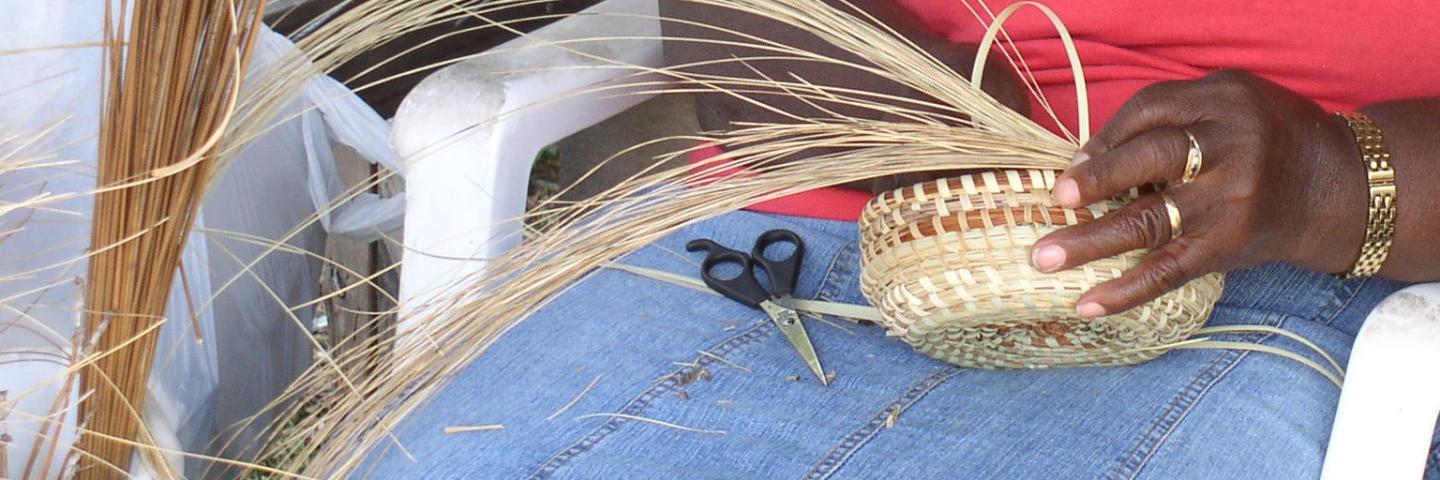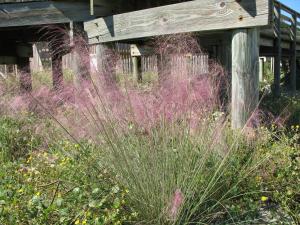Sweetgrass - a historically important native grass for coastal conservation

Sweetgrass is a clump-forming perennial grass that is native to the southern Atlantic and Gulf coasts. The leaves of this grass are used by the Gullah community, descendants of enslaved Africans in the South Carolina coastal area, as the base material for their coiled basketry.
Sweetgrass (a.k.a. gulfhairawn muhly, Muhlenbergia filipes) is a clump-forming perennial grass that is native to the southern Atlantic and Gulf coasts. It has narrow, rolled leaves that can grow to almost 4-feet tall. The purplish flowers are held in an open, diffuse panicle-type seedhead. The common name "sweetgrass" is derived from the fresh, corn silk fragrance of the leaves or "threads". Sweetgrass is more than just another native grass in the coastal conservation toolkit, it is quite literally woven into cultural tradition of a segment of African American history.
The leaves of this grass are used by the Gullah community, descendants of enslaved Africans in the South Carolina coastal area, as the base material for their coiled basketry. The Gullah are a recognized cultural group with distinctive sociological traditions. The craft of making these baskets came from the slave’s African homelands and has been passed down through the generations. The raw materials used were harvested locally and include sweetgrass leaves, longleaf pine (Pinus palustris) needles, and needlegrass or black rush (Juncus roemerianus) stems. Clusters of these base materials were sewn together with narrow strips cut from the leaves of saw palmetto (Sabal palmetto) plants. The original purpose of these baskets was entirely functional, mainly to carry out rice production activities; however, they are now recognized as an art form and their marketing provides a major source of income for the Gullah basketmakers.

The South Carolina sweetgrass populations have been seriously impacted by urbanization and remaining populations are located in areas that have no or extremely limited access. Sea Islands Germplasm is derived from sweetgrass seed collected in the 1990s by Dr. Robert Dufault of Clemson University, on the beach front on Kiawah Island, SC, and Little St. Simons Island, GA. Seed and plants of this material were given to the Brooksville Plant Materials Center for preservation and propagation at the request of Tommy Socha (ret.), U.S. Army Corps of Engineers, Charleston District. The Corps of Engineers, Charleston District, is using Sea Islands Germplasm raised by local nurseries in coastal restoration plantings to provide a source of material for the local Gullah basketmakers to harvest and for soil stabilization.
For more information on the availability and use of Sea Islands Germplasm sweetgrass, contact M.J. Williams at the Brooksville Plant Materials Center. For additional information on specific species of plants mentioned, please see the USDA PLANTS database. Technical information and guidance on the use of conservation plants for coastal and shoreline protection and restoration can be found on the Plant Materials Program website or contact the nearest Plant Materials Center or plant materials specialist.

